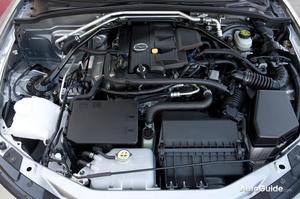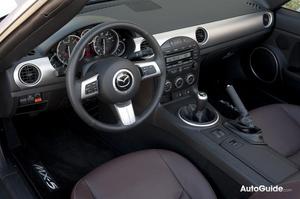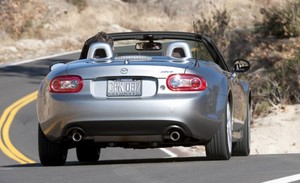Believe it or not, there is still a fairly low-priced two-seater with an open top, engine in front and rear wheel drive, a near perfect 50/50 weight distribution and a stick shift transmission.
Mazda's MX-5 Miata is the best-selling sports car in history and more people race their little darlings at autocross and other amateur and professional events than any other car.
And everyone loves a two-seater. It's the best way to avoid driving the relatives around when they visit and you never have to help your friends when they move.
Miata was designed by a team in the company's Irvine, CA offices. Tom Matano, Mark Jordan, Bob Hall, Wu Huang Chin and Koichi Hayashi were in-charge down the 405, engineering and styling the entire car before it went to Hiroshima, Japan for final tune-ups. Matano, in fact, helped start the Miata Club of America and turned it by far into the biggest enthusiast group for a single model in the country, perhaps the world.
The 2010 Miata we tested is the 21st birthday edition of the car, now only in its third generation. Why stick with the same basic model for so many years? Because from Car #1, there was little to fix or change (other than having to drop the engine to change the oil filter...but that's been fixed).
Out of the chute, the car looked and ran great, didn't leak from its convertible top (almost a wonder in 1989), is now available with a power folding hardtop (which may make it the perfect sports car) and base prices between $23,000 and $29K.
We can report that Miata remains true to the goals of the Mazda's original designers: build a fun, responsive roadster in the tradition of cars including MG, Triumph, but build it so it won't break.
MX-5 is fun, smart, low to the ground, modestly powered, nicely priced and handles like its on rails. It's the closest thing to a go-kart for the street. Or a skateboard.
Still, Miata is sometimes derisively called a "secretary's car," which refers to the car's somewhat anemic 2.0 liter 16-valve DOHC 167-horsepower four-cylinder powerplant (the auto tranny puts 150 horses to the ground; 140 pound feet of torque makes for a satisfying launch at the Stop Light Grand Prix). 
Truth be told, the heaviest Miata sold, with an automatic transmission, weighs-in at a feathery 2542 pounds with a 52% front/48% rear weight distribution. This makes the 167 horse engine feel a lot more powerful than it really is and helps tremendously in handling, steering and stopping (when using engine torque to slow with the stick).
One major reason the engine never got too powerful (originally it was a mere 1.6L) was for insurance reasons. The car is aimed primarily at under-40 types, and insurance for those folks is expensive enough. Add a high-powered car to that equation and insurance might be impossible to get or pay for. So keeping it modestly-powered keeps ownership costs lower. Some aftermarket companies make bolt-on turbocharger kits for Miata owners and one outfit even put a Ford V8 in that front bay which made for a frankly dangerous ride. Even a front engine/rear driver has its limits.
In 1989, when Miata first came to America, I drove literally one of the first ones off the boat from the company's docks in Oxnard. My photographer, David Gooley, and I drove the car back to LA on PCH and got some beautiful, iconic shots of this early Miata framed by a Pacific Ocean sunset. Of course in those days we used something called film, not digital numbers, to take pictures.
Fewer than 5% of cars and trucks sold in America are ordered with a standard transmission; automatic and CVTs have taken that market over completely. But there are still a lot of drivers who crave the control, the sounds, the visceral feel of a stick shift, the active involvement in their driving. If so, Miata might be your next car; especially if that new Cayman or used Miura are out of your league (they are out of mine!).
